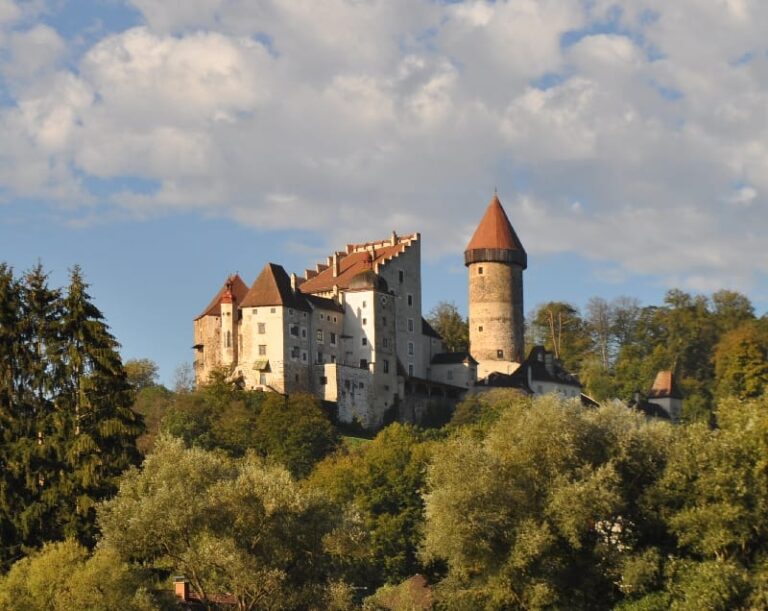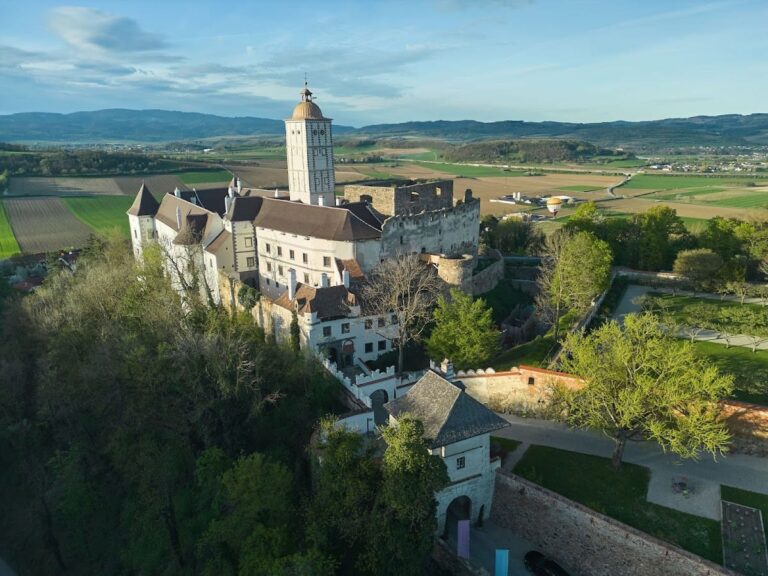Greinburg Castle: A Late Medieval Fortress and Cultural Site in Austria
Visitor Information
Google Rating: 4.6
Popularity: Low
Google Maps: View on Google Maps
Official Website: www.schloss-greinburg.at
Country: Austria
Civilization: Unclassified
Remains: Military
History
Greinburg is situated on a granite outcrop above the town of Grein in Austria and was built by the local nobility of the late medieval period. This castle arose from the efforts of the Prüschenk brothers, Heinrich and Siegmund, members of the Barons of Stettenberg, who received permission from Emperor Friedrich III between 1488 and 1493 to erect a fortification on the steep rock called Hohenstein. Its construction aimed to secure the Machland region from incursions by Bohemian, Hungarian, and Turkish forces.
Originally named Stettenfels, the castle underwent a name change to Heinrichsburg in 1504, likely reflecting the influence or commemoration of one of its founders. By 1533, the name Greinburg came into use, coinciding with the castle’s new role as the seat of the Machland regional court. This placement made it an administrative center for local governance. Later, in 1572, when the Struden court was relocated, Greinburg became the hub for the lower Machland and Strudengau areas, thereby expanding its judicial and administrative significance.
Ownership of Greinburg changed through several hands across centuries. Following the Prüschenk family, the castle passed to Johann Loeble, an imperial treasurer, in 1534. Subsequent transfers occurred through marriage alliances and sales, involving notable families such as the Meggau and Dietrichstein lineages. In 1709, it entered the possession of Franz Ferdinand Count of Salburg. Its history took a significant turn in 1823 when Duke Ernst I of Saxe-Coburg and Gotha acquired the property. This acquisition connected the castle to the ducal house and later to Queen Victoria of the United Kingdom, who shared ownership through family relations.
During the turbulent years of the Second World War, Greinburg was repurposed as a branch factory for the company Voigt & Haeffner in 1944. Early in 1945, the castle housed a subcamp of the Mauthausen concentration camp, where forced labor was directed toward construction work. After the war, the Soviet army occupied the castle for a period before the property was returned in 1958 to the Saxe-Coburg and Gotha family foundation.
Beginning in 1970, the castle found a new cultural role as the home of the Upper Austrian Shipping Museum, a project initiated by the family foundation with artifacts on loan from regional museums. Between 1976 and 1987, a thorough restoration took place, preserving the castle’s historical integrity. Following these renovations, Greinburg’s representative rooms were opened to the public on a seasonal basis.
Remains
Greinburg presents a late medieval fortress arranged around a rectangular plan, a design notable for being among the earliest of its kind north of the Alps. The castle’s complex includes four main tower structures, supplemented by an additional gate tower that controls access. Central to the layout is the palas, the primary residential building, accompanied by a chapel featuring an early Baroque Christmas altar, illustrating the site’s religious connections.
One of the most impressive interiors is the Great Knights’ Hall. Measuring around 30 meters long, 16 meters wide, and nearly 14 meters tall, this hall is distinguished by a late Gothic diamond vault, a form of ribbed ceiling featuring a pattern resembling interlocked diamonds. Another notable chamber, the Small Knights’ Hall—also known as the Donau-Saal (Danube Hall)—offers additional gathering space. The Sala terrena, a ground floor hall, is adorned entirely in pebble mosaics, an uncommon decorative technique involving small, rounded stones set into patterns.
The castle’s courtyard is designed as an arcade courtyard, featuring covered walkways supported by columns that surround the open space. Higher in the building, the so-called Coburg festival rooms occupy the second floor. These rooms are furnished with antique pieces and display a collection of portraits connected to the ducal family of Saxe-Coburg and Gotha. Access to these rooms is possible through guided visits, reflecting their preserved state and historical importance.
As part of its cultural adaptation, Greinburg houses the Upper Austrian Shipping Museum within its walls. The museum’s exhibits include detailed scale models illustrating the inland waterway traffic that has long characterized the Danube and its tributaries. A highlight is a 15-meter model of a ship convoy, alongside models of rafts and the Maria Anna, the first steamship to navigate these waters. Many of these items come from the regional State Museums, contributing to a rich display of maritime history.
The entire castle complex, including adjacent economic buildings like storerooms or stables, underwent extensive restoration during the late 20th century, between 1976 and 1987. These efforts preserved the castle’s historical architecture while enabling visitor access to its representative rooms during the months from May through October. The maintenance of these features allows Greinburg to retain its character as Austria’s oldest residential castle, standing prominently on its granite perch above the Danube.










